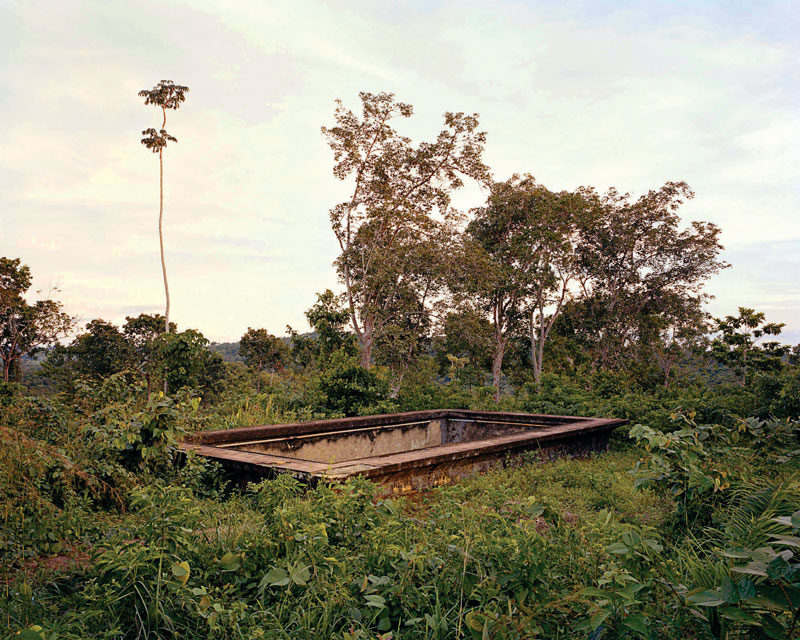[Spring/summer 2012]
Scott Chandler
Fordlândia
Galerie Les Territoires, Montreal
September 1 to 20 September 2011
Scott Chandler’s recent work opens a window on a place and a time unknown to us. With an “under-the-radar” documentary ethic and his cumbersome camera equipment, he travelled to the Brazilian Amazon to photograph eloquent ruins hidden for generations from the outside world.
Like the protagonist of J. G. Ballard’s post-apocalyptic novel The Crystal World – Edward Sanders, an English physician – Chandler, a Montreal-based photographer, has a rare sense of purpose and an innate ability to home in on the odd and wayward. Whereas Ballard’s protagonist is seeking a fictional leprosy treatment facility in the jungle as the very jungle is crystallizing around him, Chandler is seeking out Fordlândia, a defunct but real community that has met with contagion and its own demise. The radii marked out by these respective journeys are perpendicular and bear eerie thematic parallels.
Some discussion of the historical Fordlândia is in order before we plunge into the jungle. In 1928, the Ford Motor Company established, in a defining act of imperialist zeal, the town of Fordlândia in the heart of the Brazilian Amazon. For the company, the site was to function as a workers’ community qua rubber plantation to supply cultivated rubber for the automobile-manufacturing operations at Ford headquarters in the United States. For American industrialist Henry Ford, it also represented an “ideal” (idealized) community based on his own childhood memories of small-town America (think, suburban Detroit).
Ford had negotiated an agreement with the Brazilian government granting his satellite company huge tracts of land on the banks of the Rio Tapajós near the city of Santarém, Brazil, in exchange for a 9 percent interest in the profits generated. Factories and plantation fields, schools, a movie theatre, a hospital, a cemetery, and even a golf course were soon up and running. Roads were paved with asphalt brought over from stateside, electricity was generated from a hydroelectric power plant, and red fire hydrants were imported from Detroit. American managers were brought in to supervise the indigenous plantation workers, who were force-fed American food, etiquette, and, on weekends, the English language. No drinking was allowed. Both smoking and extramarital affairs were forbidden by Fordlandia law.
Paradise American-style had a short shelf life in the jungle. Imported automotive engineers were decidedly incompetent at growing rubber trees, and the Brazilians soon violently bit the American hand that was force-feeding them. Now, as Scott Chandler shows us, only muddy tracks, overgrown jungle flora and fauna, and weird remnants remain. A few stray squatters occupy some of the houses. Where once an American dream was forcibly inculcated, now the jungle has answered. Immediately after Ford’s own demise, his Amazonian utopia was abandoned and forgotten.
The mysterious phenomenon crystallizing the jungle along with its living creatures in Ballard’s novel reminds us of the vitrified remains of Fordlândia. There is more than enough surviving detail to provide any viewer with a sumptuous, if unsavoury, feast of the remains. Chandler’s journey, like Ballard’s – and like Graham Greene’s, described in Journey Without Maps before him – is nothing less than an exotic transit from the ordinary to the outré, with its own interior and psychological planes and perspectives.
We don’t know what happened to Chandler as he made his perilous journey inward, and we don’t have to. We do know that he brought along Ballard’s thousand-page short-story collection to “get in the mood.” We can hope that he brought some overproof bourbon as well. In any case, he delivers the goods with rare élan and panache. In images that speak intimately of ruination – and the myriad voices of time – he evokes an experiment in cultural transplantation as wrongheaded and ruinous as eugenics.
We do know that, en route toward the depths of the forest, there was hardship and privation. Chandler had to live on site, and indeed, from all reports, his time in Fordlândia gave the phrase “roughing it” a whole new meaning.
Chandler’s stealth-mode documentary ethic drew a line in the sand between reporting on and embellishing the truth. His images show the genuine remnants of Fordlândia and its remaining settlements with an eloquence and Socratic honesty exceptional in tenor and scope. The ruined cemetery with its uprooted tombstones, the broken swing in the playground, the house all but hidden in weeds – all these reflect a pervasive sense of loss, failure, and desolation. A winding-down of the temporal, a widespread sense of ruination and waste: sundered ideals and broken dreams. Dystopia.
Ford, like B. F. Skinner in Walden Two, thought that he could perfect society by building a planned utopian community – this one with model factories, and with pristine houses and well-watered lawns to go with them – and Chandler sheds an unsparing light on his hubris and naiveté. What a fool he was. But, as Chandler’s photographs illustrate, within the hostile jungles of Brazil, his defeat and humiliation were as obvious decades later as a radiation imprint on a blank wall. Fordlândia also offers, by extension, a rueful elegy on a dying, and perhaps dead, America.
Chandler establishes a threshold. He then invites us to share it with him as voyeurs empowered to discover the truth. Always at a certain remove, but never estranged from the truth of what we are seeing, we witness the resonant artefacts that he offers up as first-level perceptual information. He invites us to stand on the threshold of these images alongside him, and to witness the evolving imprint of time and taste the ethics of memory. These views shine with integrity, speak reams about the “American way,” and are unassailable in their formal verities, radiant in their truth-telling, and, above all, quietly ferocious in their critique.
James D. Campbell is a writer on art and independent curator based in Montreal. The author of over one hundred books and catalogues on contemporary art and artists, he contributes frequently to visual arts publications across Canada and abroad.


